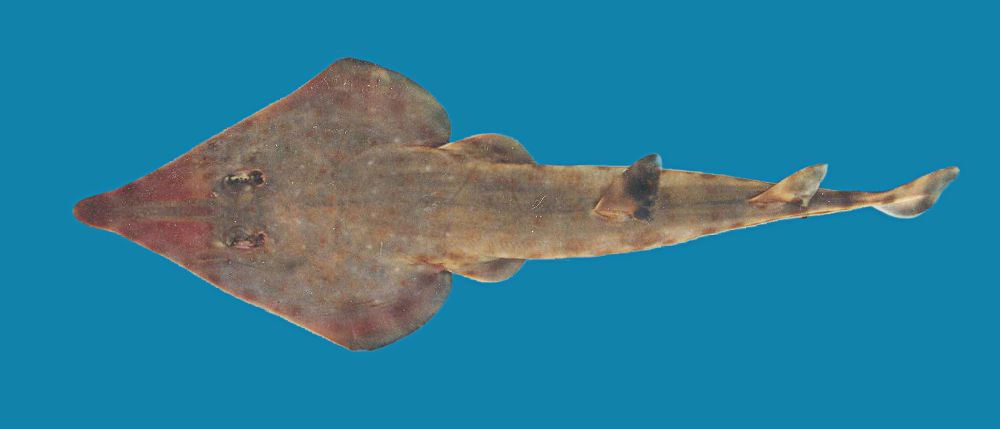Rhinobatos whitei
Last, Corrigan & Naylor, 2014
Classification: Elasmobranchii Rhinopristiformes Rhinobatidae
Reference of the original description
Rhinobatos whitei, a new shovelnose ray (Batoidea: Rhinobatidae) from the Philippine Archipelago. Zootaxa, 3872(1), 31–47
Rhinobatos whitei, a new shovelnose ray (Batoidea: Rhinobatidae) from the Philippine Archipelago. Zootaxa, 3872(1), 31–47
Types
Rhinobatos whitei
Holotype: PNM: 15189 (formerly SUML F1086 and JPAG 079); Paratype: CSIRO: H 7542–01 (formerly SUML JPAG 300); CSIRO: H 7542–02 (formerly SUML JPAG 301); CSIRO: H 7542–03 (formerly SUML JPAG 306); CSIRO: H 7542–04 (formerly SUML JPAG 308); CSIRO: H 7542–05 (formerly SUML JPAG 310); PNM: 10318 (formerly SUML JPAG 277); SUML: JPAG 309; SUML: BRU 144; SUML: MMLM 001; SUML: F1 (formerly MMLM 012);
Rhinobatos whitei
Holotype: PNM: 15189 (formerly SUML F1086 and JPAG 079); Paratype: CSIRO: H 7542–01 (formerly SUML JPAG 300); CSIRO: H 7542–02 (formerly SUML JPAG 301); CSIRO: H 7542–03 (formerly SUML JPAG 306); CSIRO: H 7542–04 (formerly SUML JPAG 308); CSIRO: H 7542–05 (formerly SUML JPAG 310); PNM: 10318 (formerly SUML JPAG 277); SUML: JPAG 309; SUML: BRU 144; SUML: MMLM 001; SUML: F1 (formerly MMLM 012);
Description :
Citation: Rhinobatos whitei Last, Corrigan & Naylor, 2014: In: Database of modern sharks, rays and chimaeras, www.shark-references.com, World Wide Web electronic publication, Version 01/2026
Please send your images of "Rhinobatos whitei" to info@shark-references.com

Rhinobatos whitei Last, Corrigan & Naylor, 2014, adolescent male holotype, 597 mm TL (PNM 15189). Dorsal view (fresh from copy of printed image); © Peter Last, CSIRO - Australian National Fish Collection

Rhinobatos whitei Last, Corrigan & Naylor, 2014, adolescent male holotype, 597 mm TL (PNM 15189). Dorsal view (fresh from copy of printed image); © Peter Last, CSIRO - Australian National Fish Collection
Common names
Philippine Guitarfish
Philippine Guitarfish
Short Description
Orignal description of LAST, SHANNON & NAYLOR, 2014 [21583]: A species of the genus Rhinobatos distinguished by the following combination of adult characters: wedge-shaped disc with an moderately concave anterior snout margin, width 31–35% TL, disc length 1.3–1.4 times width; snout length 3.0–3.4 times interspiracular distance, 3.9–5.2 times interorbital width; medium-sized orbit, 1.4–1.7 times spiracle length; weakly oblique nostrils, their length 1.3–1.6 times internarial distance; preoral length 6.8–7.8 times internarial distance; anterior nasal flaps penetrating slightly into internarial space but well separated at their insertion; posterior nasal flaps broad; large spiracles with two folds, outermost fold distinctly longer than inner fold; ridges of rostral cartilage almost parallel, converging slightly anteriorly but not constricted medially; anterior cartilage subtriangular; distance between fifth gill slits 3.0–3.4 times in ventral head length; prebranchial sensory pore patch obvious, extending to just behind first gill slit; postscapular sensory canal obvious, with exposed lateral pores, grooved; thorn patches on supraorbit, nuchal and scapular regions, and dorsal midline rudimentary, not conspicuous; pelvic-fin inner margin longer than its base in males, subequal in females; interdorsal distance 2.6–3.2 times length of first dorsal-fin base; dorsal caudal margin 2.1–2.6 times preventral margin; 173–179 post-synarcual centra; 50–53 nasal lamellae; dorsal surface of adults brownish, covered with diffuse orange and dusky blotches, and indistinct pale spots; melanophores pronounced on dorsal surface, and dorsal fins largely pale anteriorly, darker posteriorly with a blackish blotch above the free rear tip when fresh.
Orignal description of LAST, SHANNON & NAYLOR, 2014 [21583]: A species of the genus Rhinobatos distinguished by the following combination of adult characters: wedge-shaped disc with an moderately concave anterior snout margin, width 31–35% TL, disc length 1.3–1.4 times width; snout length 3.0–3.4 times interspiracular distance, 3.9–5.2 times interorbital width; medium-sized orbit, 1.4–1.7 times spiracle length; weakly oblique nostrils, their length 1.3–1.6 times internarial distance; preoral length 6.8–7.8 times internarial distance; anterior nasal flaps penetrating slightly into internarial space but well separated at their insertion; posterior nasal flaps broad; large spiracles with two folds, outermost fold distinctly longer than inner fold; ridges of rostral cartilage almost parallel, converging slightly anteriorly but not constricted medially; anterior cartilage subtriangular; distance between fifth gill slits 3.0–3.4 times in ventral head length; prebranchial sensory pore patch obvious, extending to just behind first gill slit; postscapular sensory canal obvious, with exposed lateral pores, grooved; thorn patches on supraorbit, nuchal and scapular regions, and dorsal midline rudimentary, not conspicuous; pelvic-fin inner margin longer than its base in males, subequal in females; interdorsal distance 2.6–3.2 times length of first dorsal-fin base; dorsal caudal margin 2.1–2.6 times preventral margin; 173–179 post-synarcual centra; 50–53 nasal lamellae; dorsal surface of adults brownish, covered with diffuse orange and dusky blotches, and indistinct pale spots; melanophores pronounced on dorsal surface, and dorsal fins largely pale anteriorly, darker posteriorly with a blackish blotch above the free rear tip when fresh.
Distribution
Philippine Archipelago, collected from fish markets in the central and southern Philippines [21583]
Philippine Archipelago, collected from fish markets in the central and southern Philippines [21583]
Dentition
Orignal description of LAST, SHANNON & NAYLOR, 2014 [21583]: upper jaw with ca. 65–92 tooth rows
Orignal description of LAST, SHANNON & NAYLOR, 2014 [21583]: upper jaw with ca. 65–92 tooth rows
Remarks
shark-references Species-ID=14119;
shark-references Species-ID=14119;
















